

Frederick Madison Smith LibraryGraceland University, Lamoni, Iowa |
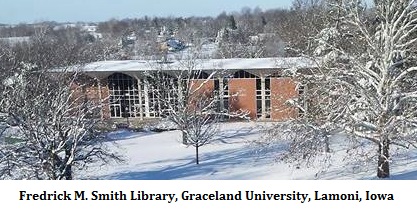 |
|
Graceland University's library, located west of the Administration
Building, opened in 1966, the first facility at Graceland specifically
built at a library. It was named in honor of Frederick Madison Smith. Graceland's original library began with the appointment of a library committee by the Board of Directors on October 2, 1895. Committee members were Dr. J. H. Hansen, E. A. Blakeslee, Daniel F. Lambert, and Professors Thomas J. Fitzpatrick and Joseph T. Pence. The first committee meeting was held on Monday morning of October 7, 1895, Dr. Hansen chairman. The committee decided to solicit book donations and resolved that the library would not include materials which would not assist in the college's educational programs. Graceland's first library was located on the second floor of the France Building, located in downtown Lamoni at 126 Linden Street. The France Building had been rented because "the College Building" (as the Administration Building was called then) had not been completed and ready for occupancy when Graceland's first classes commenced on September 17, 1895. The College City Chronicle reported on October 18, 1895 that the college had acquired approximately 100 volumes, "a nucleus of what is expected to be a first-class college library." On October 30, 1895, the Board of Directors appointed Thomas J. Fitzpatrick as Graceland's first librarian. Mr. Fitzpatrick made a list which was presented to the Board of Directors on November 16, 1896 along with a request authorizing $100 to be made toward the purchase of books. The Board approved the list with the exception of declining Mr. Fitzpatrick's request for Chambers Encyclopedia and substituted it with their preference, Encyclopedia Britannica instead. On March 31, 1896, Mr. Fitzpatrick reported to the Board that there were 565 volumes in the library. The library, along with Graceland's equipment and supplies, was moved into "the College Building" during Christmas break of 1895, and classes resumed in the Administration building on January 1, 1897. The first sizeable monetary donation to the library was $89.80 made by the Zion's Religo Society in April of 1897. After the move onto campus, Graceland's library was originally located in the northeast room on the main floor of the Administration Building. Later, it was moved to the southwest corner into a 23' x 29' room that could accommodate 15 people at a time. The hallway was used for additional reading space as needed in 1912. Stacks were kept in the old shop room at the southwest corner of the basement. On May 5, 1911, Mr. Fitzpatrick and the Board discussed the possibility of a separate library building, but no action was taken. The library moved into a more spacious room in the Administration Building during the 1918-19 school year and Lyda Elefson was hired as a full-time librarian. This move provided seating for 60 students at a time. Briggs Hall was erected and dedicated on September 16, 1921. After the spring of 1929, the library was moved to the top floor of Briggs Hall. By 1945, Graceland's library had grown to include 18,000 volumes. Consequently, the library by this time occupied the top floor and half of the middle floor of Briggs Hall. |
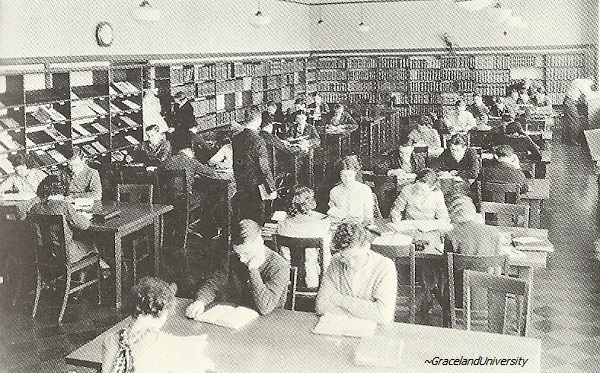 The Library, 1937-38 |
Frederick Madison Smith, the son of Joseph Smith III and his second
wife, Bertha Madison Smith, was born on January 21, 1874, Plano,
Illinois, and was baptized on July 20, 1883. His paternal grandfather
was Joseph Smith, Jr., found of the Latter Day Saint movement.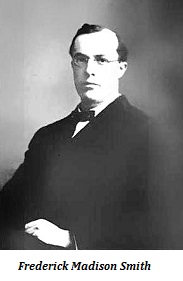 Frederick,
also known as Fred M., was educated at Iowa City Academy (1895), the
University of Iowa at Iowa City (1896), and was the first graduate of
Graceland College, obtaining a B.A. degree in 1898. He obtained his M.A.
degree from the University of Kansas in 1991 and his Ph.D. from Clark
University in 1916. Frederick,
also known as Fred M., was educated at Iowa City Academy (1895), the
University of Iowa at Iowa City (1896), and was the first graduate of
Graceland College, obtaining a B.A. degree in 1898. He obtained his M.A.
degree from the University of Kansas in 1991 and his Ph.D. from Clark
University in 1916.Fred M. was married on August 3, 1897 to Alice Lyman Cobb. Fred M. became a counselor in the RLDS Church's First Presidency in 1902. As his father's health declined, Fred M. assumed greater and greater responsibilities in the management of the church and its auxiliary institutions. Joseph Smith III died on December 10, 1914, and Fred M. was ordained as the new Prophet-President the following spring on May 5, 1915 and held that position until his death. Fred M. was known for his interests in applying the principles of the newly emerging fields of sociology and social welfare to the Church's thinking on the principles and doctrine of Zion. Smith was influenced by the contemporary Social Gospel movement, which endeavored to apply Christian ethics to societal problems, including social justice, health care, and care for the poor, for orphans, and the elderly. In broad terms, Smith felt the need to address these issues as part of the overall call to "build Zion." In this way he both embraced and modernized his grandfather Joseph Smith Jr.'s vision to build a literal city of Zion in Independence, Missouri. In order to fulfill his vision, Smith initiated a number of ambitious programs, including the construction of the Auditorium, expansion of the Independence Sanitarium (later known as Independence Regional Hospital), construction of an old-age home in Independence originally known as "Resthaven", and a planned agricultural cooperative in Atherton, Missouri. As part of his modernizing program, Smith was an early adopter of radio. In 1924, the RLDS Church's radio station, known as KFIX (later KLDS), became the first church-owned radio station in the United States to be licensed. He also presided during the difficult depression years which stalled or halted many of his projects, as the church faced issues of major financial debt. Alice Lyman Cobb Smith, one of the charter members of the Patroness Society, died on May 4, 1926. Fred M. died on March 20, 1946. They were interred at Mound Cemetery, Independence, Missouri. |
|
Graceland observed her 50th anniversary with a program held at the
Coliseum Theater, Lamoni, Iowa, on September 17, 1945. Frederick M.
Smith, charter Graceland student, first graduate and President of the
RLDS Church, was the keynote speaker. In his speech, Smith expressed his
hope that some day Graceland would have an entire building used for a
library and he envisioned that Graceland would become a university in
the future. Both of Smith's visions came into reality within the next 50
years of Graceland's history. After Frederick Madison Smith's death on March 20, 1946, the RLDS World Conference of April 1946 appointed a committee, recommended by the First Presidency, to investigate a fitting memorial to Mr. Smith. The General Conference approved a motion to build a Frederick Madison Smith on March 20, 1947. The General Conference also moved to raise $250,000 toward construction costs during the next five years. The RLDS World Church Board of Appropriations approved a $258,300 loan toward the library's estimated $8000,000 construction on September 18, 1964. At this time, Graceland had collected $275,000 from the 1962 and 1964 RLDS World Church appropriations, College Day and development funds. A $30,000 three-year pledge was made in memory of Hy-Vee Food Store founders David m. Vredenburg and Charles L. Hyde to finance the furnishings for the top floor of the library. Much of the funding for the new library came from a federal grant provided by the Higher Education Facilities Act. On July 20, 1965, almost a full twenty years after Frederick M. Smith's speech, ground was broken for the library. Don Larson was the project foreman. Many concepts for the new library came from Cleo Hanthorne Moon, Graceland's longtime librarian. Specifications stipulated that the name of a U.S. president be printed on a large construction sign in front of the construction site. The Tower noted in the January 14, 1966 issue that, "Some students seem to have missed the last election results because, lo and behold, after one dark night had passed, Barry Goldwater's name had replaced Lyndon B. Johnson's." On Wednesday, July 20, 1966, a crew consisting of nearly 200 people amassed at Briggs Hall at 8 a.m. The crew included nearly all of the faculty, many summer school students and several townspeople. Their goal was to transport boxes containing the library's 50,000 volumes from Briggs Hall to the new library. Initially, it was planned to pass the boxes hand-to-hand down the line of volunteers, however this procedure quickly proved to be too tiresome. As a result, most of the boxes of books were loaded onto trucks and driven to the new library. The move was accomplished by 5 p.m. that day. The Frederick Madison Smith Library opened in September of 1966. |
 |
|
The library contains 39,099 square feet of floor space throughout
its three levels and was designed to hold up to 126,000 books.
Constructed with brick, the building features windows made of gray plate
glass and fiberglass panels which minimize glare from the sun. The
library's dendriform roof allows water to drain into the square-shaped
columns which support the building. The library's final cost of
construction was $877,335. At the main entrance to the library is a metal plaque which dedicates the building to Frederick Madison Smith. The plaque reads: "He delighted in learning, believed in education as essential to freedom and dignity, and in a strong, healthy society for effective service to God and mankind." 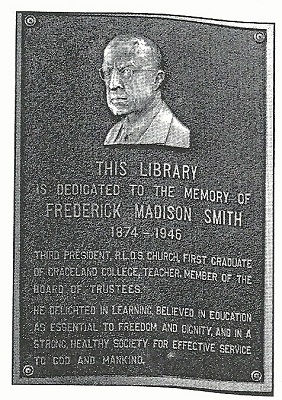 A
tradition at Graceland is for students to rub the top of the plaque's
image of Mr. Smith's head, and act which allegedly helps strengthen the
knowledge that was gained while studying inside of the library. A
tradition at Graceland is for students to rub the top of the plaque's
image of Mr. Smith's head, and act which allegedly helps strengthen the
knowledge that was gained while studying inside of the library.The main and upper levels of the library were designed to seat approximately 350 people with more than 50 winged study carrels. Bound periodicals and reference books are located on the main level. The reading area located on the west side of the main level was named the Phillip and Emma Keen Reading Room. On the top floor are individual typing rooms were insulated and designed to contain sound. The basement level, designed to seat 250, originally included 20 stereophonic listening stations in the southwest corner. When the library opened, the student teacher's curriculum room was moved from Kelley Hall to an expanded area in the library basement. On Sunday, May 7, dedication ceremonies for the Frederick Madison Smith Library began at 2:30 p.m. at Zimmerman Hall. The keynote speaker was Dr. Maxwell White, 1914 Graceland graduate and professor of history at Northeastern State College, Tahlequah, Oklahoma. Verne L. Deskin delivered the invocation; student body president Bill Bunch delivered a statement; Herbert Lively offered the dedication prayer; and, RLDS president W. Wallace Smith [Frederick's half-brother] delivered the concluding address which named the new library. At 3:30 p.m., the ceremony was moved to the library and the keys were presented to Merle Spence of the Board of Trustees, college president William T. "Bill" Higdon, and librarian Cleo Hanthorne Moon. Mrs. Moon officially unlocked the doors and the library was open for a reception and tours. Paul M. Edwards chaired the dedication committee. |
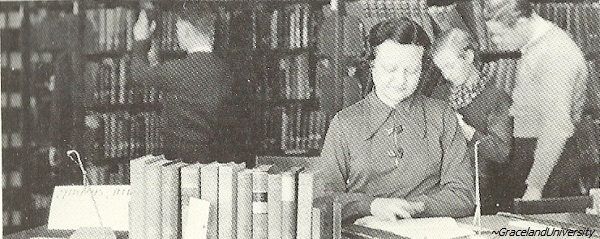 Cleo Hanthorne Moon, year unknown |
|
Upon Mrs. Moon's retirement, Gerald R. Kruse became the head librarian. The library began a cooperative borrowing arrangement with the Kansas City Public Library and the Tarkio College Library in the fall of 1967. This arrangement increased book selections by 80,000 volumes. The periodicals room was named in honor of May Belle Davenport in 1971. Ms. Davenport, a California resident, left $75,000 to Graceland in her will. In the fall of 1971, an inter-library lending program and microfilm printout service was set up between schools affiliated with the Kansas City Regional Council for Higher Education (KCRCHE). This program and service allows Graceland students to check out books from any of the 16 KCRCHE school members. During 1971-72, the library connected to the Iowa State Traveling Library, which put Graceland and four other academic libraries on a Teletype connection to the state library. This assists in locating any book held by the libraries within this link. As the final-year project of the Title II grant from 1985, the library began automating its catalog access system on April 11, 1990. The new computerized system can check if the material is available or located on closed reserve, and can locate items based on key word searches, along with traditional searches by author, title or subject matter. Bar codes were added to student I.D. cards in September of 1991, permitting automated checkout procedures. In 1991, the old card catalog was removed. Most of the cards were recycled but some were held for a card burning ceremony on Thursday, March 5, 1992. Library director Diane Shelton lit the match. |
| DuROSE ROOM |
|
On June 15, 1966, Arthur DuRose of Flint, Michigan, presented Graceland
with a donation of $25,000 toward a rare book room in memory of his
recently deceased wife, Muriel. The DuRose Room is located at the
southwest corner of the building's top level. The DuRose Room includes
archival books, magazines, photos, and other materials related to
Graceland and RLDS church history. The room was used as a meeting room
previously before becoming a depository for historical church materials
in 1971. Located within the DeRose Room is a bust of Frederick Madison
Smith which was presented to Graceland by the young people of the RLDS
Church during the December 2, 1948 assembly. Over the years, the following donations were made to Graceland's library: The Ruth Lyman Smith collection of 155 volumes on child training and the home was loaned to the college by Ruth's husband, Frederick M. Smith. The Frederick Madison Smith collection of 1,088 volumes on religion and social science were placed on indefinite loan to Graceland. In 1930, the collection was finally placed on shelves within the library. The Esther Irene Layton Memorial Library of 404 books were presented to the library by Esther's mother, Ida A. Layton, in October of 1938. The collection included oak bookcases from Esther's home. The collection consists mainly of literature and some fiction and nonfiction. Esther Layton was a Graceland English professor from 1924 to 1926. She was teaching in Independence, Missouri, at the time of her death in September of 1938. The class of 1921 presented Graceland College with a heroic-sized plaster-of-paris statue of Abraham Lincoln, which was unveiled during Class Day exercises on Wednesday afternoon of June 8, 1921. The statue was placed in the library when it was located at Briggs Hall. It accompanied the library when it was moved to the Frederick Madison Smith Library in 1966. |
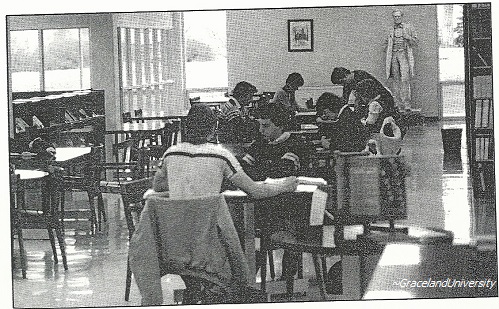 |
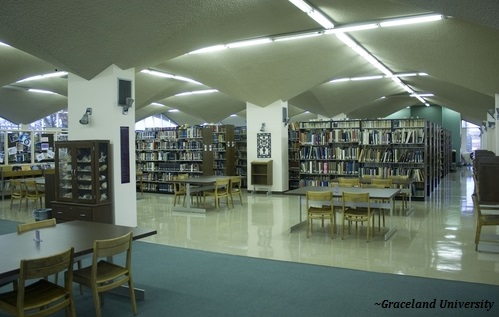 |
|
SOURCES: en.wikipedia.org/wiki/Frederick_M._Smith; Edwards, Paul M.
"The Hilltop Where. . . An Informal History of Graceland College." Pp.
130-31. Venture Foundation. Lamoni IA. 1972. Goehner, David. "The
Graceland College Book of Knowledge: From A To Z." Pp. 97, 108-12,
198-200. Herald House. Independence MO. 1997. Transcriptions by Sharon
R. Becker, December 2015. NOTE: Graceland University expressly granted permission to Decatur County IAGenWeb to use photographs and materials for the sole purpose of this website. Please, extend courtesy toward Graceland University and Decatur County IAGenWeb ~ ask before you "borrow" from this site. Thank you. These pages have been updated and reformatted by Conni McDaniel Hall, October 2019 |
| Graceland University *** Schools Directory *** Decatur County IAGenWeb |